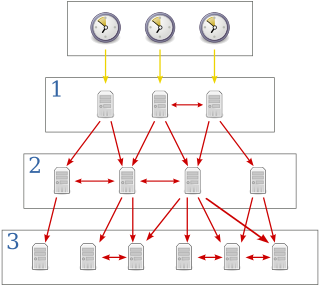Related Research Articles
In computer network engineering, an Internet Standard is a normative specification of a technology or methodology applicable to the Internet. Internet Standards are created and published by the Internet Engineering Task Force (IETF). They allow interoperation of hardware and software from different sources which allows internets to function. As the Internet became global, Internet Standards became the lingua franca of worldwide communications.
The Internet protocol suite, commonly known as TCP/IP, is a framework for organizing the set of communication protocols used in the Internet and similar computer networks according to functional criteria. The foundational protocols in the suite are the Transmission Control Protocol (TCP), the User Datagram Protocol (UDP), and the Internet Protocol (IP). Early versions of this networking model were known as the Department of Defense (DoD) model because the research and development were funded by the United States Department of Defense through DARPA.

The Open Systems Interconnection (OSI) model is a reference model from the International Organization for Standardization (ISO) that "provides a common basis for the coordination of standards development for the purpose of systems interconnection." In the OSI reference model, the communications between systems are split into seven different abstraction layers: Physical, Data Link, Network, Transport, Session, Presentation, and Application.
The Secure Shell Protocol (SSH) is a cryptographic network protocol for operating network services securely over an unsecured network. Its most notable applications are remote login and command-line execution.
Simple Network Management Protocol (SNMP) is an Internet Standard protocol for collecting and organizing information about managed devices on IP networks and for modifying that information to change device behavior. Devices that typically support SNMP include cable modems, routers, switches, servers, workstations, printers, and more.
The Address Resolution Protocol (ARP) is a communication protocol used for discovering the link layer address, such as a MAC address, associated with a given internet layer address, typically an IPv4 address. This mapping is a critical function in the Internet protocol suite. ARP was defined in 1982 by RFC 826, which is Internet Standard STD 37.
DECnet is a suite of network protocols created by Digital Equipment Corporation. Originally released in 1975 in order to connect two PDP-11 minicomputers, it evolved into one of the first peer-to-peer network architectures, thus transforming DEC into a networking powerhouse in the 1980s. Initially built with three layers, it later (1982) evolved into a seven-layer OSI-compliant networking protocol.
In the seven-layer OSI model of computer networking, the network layer is layer 3. The network layer is responsible for packet forwarding including routing through intermediate routers.
A virtual private network (VPN) is a mechanism for creating a secure connection between a computing device and a computer network, or between two networks, using an insecure communication medium such as the public Internet.

The Network Time Protocol (NTP) is a networking protocol for clock synchronization between computer systems over packet-switched, variable-latency data networks. In operation since before 1985, NTP is one of the oldest Internet protocols in current use. NTP was designed by David L. Mills of the University of Delaware.
The ISODE software, more formally the ISO Development Environment, was an implementation of the OSI upper layer protocols, from transport layer to application layer, which was used in the Internet research community to experiment with implementation and deployment of OSI during the late 1980s and early 1990s.
In computer networks, a tunneling protocol is a communication protocol which allows for the movement of data from one network to another. It can, for example, allow private network communications to be sent across a public network, or for one network protocol to be carried over an incompatible network, through a process called encapsulation.

A computer network is a set of computers sharing resources located on or provided by network nodes. Computers use common communication protocols over digital interconnections to communicate with each other. These interconnections are made up of telecommunication network technologies based on physically wired, optical, and wireless radio-frequency methods that may be arranged in a variety of network topologies.
In computing and telecommunications, the payload is the part of transmitted data that is the actual intended message. Headers and metadata are sent only to enable payload delivery and are considered overhead.
A communication protocol is a system of rules that allows two or more entities of a communications system to transmit information via any variation of a physical quantity. The protocol defines the rules, syntax, semantics, and synchronization of communication and possible error recovery methods. Protocols may be implemented by hardware, software, or a combination of both.
Security service is a service, provided by a layer of communicating open systems, which ensures adequate security of the systems or of data transfers as defined by ITU-T X.800 Recommendation.
X.800 and ISO 7498-2 are technically aligned. This model is widely recognized

Evi Nemeth was an engineer, author, and teacher known for her expertise in computer system administration and networks. She was the lead author of the "bibles" of system administration: UNIX System Administration Handbook, Linux Administration Handbook, and UNIX and Linux System Administration Handbook. Evi Nemeth was known in technology circles as the matriarch of system administration.
In computer networking, the link layer is the lowest layer in the Internet protocol suite, the networking architecture of the Internet. The link layer is the group of methods and communications protocols confined to the link that a host is physically connected to. The link is the physical and logical network component used to interconnect hosts or nodes in the network and a link protocol is a suite of methods and standards that operate only between adjacent network nodes of a network segment.

Multipath TCP (MPTCP) is an ongoing effort of the Internet Engineering Task Force's (IETF) Multipath TCP working group, that aims at allowing a Transmission Control Protocol (TCP) connection to use multiple paths to maximize throughput and increase redundancy.
The Protocol Wars were a long-running debate in computer science that occurred from the 1970s to the 1990s, when engineers, organizations and nations became polarized over the issue of which communication protocol would result in the best and most robust networks. This culminated in the Internet–OSI Standards War in the 1980s and early 1990s, which was ultimately "won" by the Internet protocol suite (TCP/IP) by the mid-1990s when it became the dominant protocol through rapid adoption of the Internet.
References
- ↑ Gregg, Michael (2007-05-01), "OSI: Securing the Stack, Layer 8 – Social engineering and security policy" , TechTarget
- ↑ "The Layer 8* Initiative". North Carolina State University, Information Technology Division. 2005-01-05. Archived from the original on 2013-10-29. Retrieved 2018-05-10.
- ↑ Farquhar, Ian (2010-12-07). "Engineering Security Solutions at Layer 8 and Above". Archived from the original on 2013-05-24. Retrieved 2018-05-10.
- ↑ Wexler, Steve Taylor and Joanie (2003-02-13). "Mailbag: OSI Layer 8 - money and politics". Network World. Retrieved 2021-11-19.
- ↑ "Layer 8 Performance Issues". Apposite Tech. 2017-10-30. Retrieved 2018-05-10.
- ↑ Mosco, Vincent (1996), The Political Economy of Communication: Rethinking and Renewal , SAGE Publications, Inc, ISBN 0-8039-8560-6 .
- ↑ "ISC 9-Layer OSI Model Cotton T-Shirt". ISC. 2015-01-14. Archived from the original on 2018-01-05. Retrieved 2018-05-10.
- ↑ RFC 2321
- ↑ Kachold, Lisa (July 2009). "Layer 8 Linux Security: OPSEC for Linux Common Users, Developers and Systems Administrators". Linux Gazette . No. 164.
- ↑ "OctoInsight's Layer8 technology helps rebranded company surge". Prnewswire. 2016-06-09. Retrieved 2018-05-10.